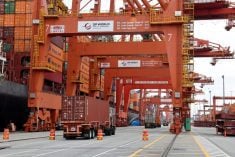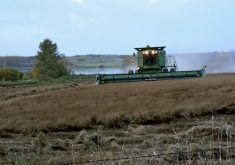BUENOS AIRES (Reuters) — Argentine corn planting is being slowed by dry weather and low market prices while most of the country’s wheat crop is flowering healthily, thanks to good weather after frosts briefly caused worries about yield damage last week, meteorologists and farmers said on Monday.
The South American grains powerhouse is the world’s No. 3 corn exporter and a big wheat supplier at a time of rising global demand.
But U.S. bumper crops have driven down the price of corn and wheat by 35 and 16 percent, respectively, while bad weather prompts Argentine farmers to seed drought-resistant soy instead.
Read Also

Canadian trade data delayed by U.S. government shutdown
Canadian international trade data for September will be delayed indefinitely due to the ongoing partial shutdown of the United States government, Statistics Canada said Friday, Oct. 24.
Prime Argentine corn sowing season — centred in northern Buenos Aires and southern Cordoba, Entre Rios and Santa Fe provinces — is from Sept. 15 to Oct. 15.
Over the last 15 days, the corn belt needed 50 millimeters of rain but got no more than 10 mm, and less than ideal rainfall is expected over the 15 days ahead, said meteorologist German Heinzenknecht of local consultancy Applied Climatology.
“The farmers who have planted corn so far are facing a high risk because there is a serious lack of moisture in the corn belt,” he said. “There is a lot of anxiety because if it does not rain substantially between now and Oct. 15, and it probably will not, the corn that has been planted could fail.”
Heinzenknecht said growers will likely switch to planting soy toward the end of October. Soy is more weather resistant than corn, costs less to grow and is exempt from the export curbs that the government puts on corn and wheat.
Corn crop estimates for the 2013-14 season have been marked down by local analysts due to these factors, with the U.S. government forecasting an Argentine harvest of 26 million tonnes, down from its previous estimate of 27 million.
“The problem with corn this season is not just the weather. It’s low market prices, relatively high cultivation costs and government policy,” said Buenos Aires farmer Santiago del Solar.
Wheat fields are entering their flowering period under mostly good conditions despite the frosts that blanketed some parts of the wheat belt — centred in southern Buenos Aires province — last week, del Solar said.
The U.S. Department of Agriculture forecast Argentine 2013-14 wheat output at 12 million tonnes, up from 10 million in the previous season.
Wheat planting intentions increased this year thanks to a local price surge caused by high early-season exports after the government approved shipments based on overly-optimistic crop expectations. Argentina should produce more than the 8.2 million tonnes it reported last season. Harvesting starts in November.
“The cold has had no effect in southern and northeastern Buenos Aires province, with accounts for 50 or 60 percent of Argentina’s overall wheat crop. These areas are in much better shape than the wheat areas of south central Santa Fe and Cordoba provinces,” Heinzenknecht said.
An ample crop is needed after last year’s thin harvest tightened supplies and drove up local bread prices. World buyers, including neighbour Brazil, also need Argentina’s wheat as global demand for grain is on the rise.
U.S. wheat exports have risen sharply this year versus 2012 as buyers look to America for supplies needed to compensate for a poor Chinese crop and possible low yields in Argentina.
While Argentine soybean exports are taxed at a whopping 35 percent, they are not subject to the export curbs that the government slaps on wheat and corn as a way of ensuring ample domestic food supplies.
Farmers say the export quotas, which can be raised and lowered throughout the year, hurt their profits by killing competition among buyers while making crop planning impossible.














